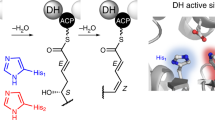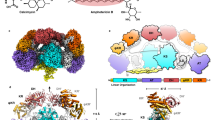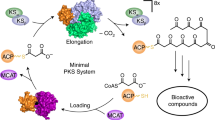Abstract
The enoylreductase (ER) is the final common enzyme from modular polyketide synthases (PKSs) to be structurally characterized. The 3.0 Å–resolution structure of the didomain comprising the ketoreductase (KR) and ER from the second module of the spinosyn PKS reveals that ER shares an ∼600-Å2 interface with KR distinct from that of the related mammalian fatty acid synthase (FAS). In contrast to the ER domains of the mammalian FAS, the ER domains of the second module of the spinosyn PKS do not make contact across the two-fold axis of the synthase. This monomeric organization may have been necessary in the evolution of multimodular PKSs to enable acyl carrier proteins to access each of their cognate enzymes. The isolated ER domain showed activity toward a substrate analog, enabling us to determine the contributions of its active site residues.
This is a preview of subscription content, access via your institution
Access options
Subscribe to this journal
Receive 12 print issues and online access
$259.00 per year
only $21.58 per issue
Buy this article
- Purchase on Springer Link
- Instant access to full article PDF
Prices may be subject to local taxes which are calculated during checkout





Similar content being viewed by others
References
Khosla, C., Tang, Y., Chen, A.Y., Schnarr, N.A. & Cane, D.E. Structure and mechanism of the 6-deoxyerythronolide B synthase. Annu. Rev. Biochem. 76, 195–221 (2007).
Smith, S. & Tsai, S.C. The type I fatty acid and polyketide synthases: a tale of two megasynthases. Nat. Prod. Rep. 24, 1041–1072 (2007).
Keatinge-Clay, A.T. A tylosin ketoreductase reveals how chirality is determined in polyketides. Chem. Biol. 14, 898–908 (2007).
Keatinge-Clay, A. Crystal structure of the erythromycin polyketide synthase dehydratase. J. Mol. Biol. 384, 941–953 (2008).
Zheng, J. & Keatinge-Clay, A.T. Structural and functional analysis of C2-type ketoreductases from modular polyketide synthases. J. Mol. Biol. 410, 105–117 (2011).
Zheng, J., Taylor, C.A., Piasecki, S.K. & Keatinge-Clay, A.T. Structural and functional analysis of A-type ketoreductases from the amphotericin modular polyketide synthase. Structure 18, 913–922 (2010).
Keatinge-Clay, A.T. & Stroud, R.M. The structure of a ketoreductase determines the organization of the β-carbon processing enzymes of modular polyketide synthases. Structure 14, 737–748 (2006).
Tsai, S.C. et al. Crystal structure of the macrocycle-forming thioesterase domain of the erythromycin polyketide synthase: versatility from a unique substrate channel. Proc. Natl. Acad. Sci. USA 98, 14808–14813 (2001).
Tang, Y., Kim, C.Y., Mathews, I.I., Cane, D.E. & Khosla, C. The 2.7-Angstrom crystal structure of a 194-kDa homodimeric fragment of the 6-deoxyerythronolide B synthase. Proc. Natl. Acad. Sci. USA 103, 11124–11129 (2006).
Alekseyev, V.Y., Liu, C.W., Cane, D.E., Puglisi, J.D. & Khosla, C. Solution structure and proposed domain domain recognition interface of an acyl carrier protein domain from a modular polyketide synthase. Protein Sci. 16, 2093–2107 (2007).
Pedelacq, J.D. et al. Experimental mapping of soluble protein domains using a hierarchical approach. Nucleic Acids Res. 39, e125 (2011).
Kwan, D.H. et al. Prediction and manipulation of the stereochemistry of enoylreduction in modular polyketide synthases. Chem. Biol. 15, 1231–1240 (2008).
Kwan, D.H. & Leadlay, P.F. Mutagenesis of a modular polyketide synthase enoylreductase domain reveals insights into catalysis and stereospecificity. ACS Chem. Biol. 5, 829–838 (2010).
Kirst, H.A. The spinosyn family of insecticides: realizing the potential of natural products research. J. Antibiot. (Tokyo) 63, 101–111 (2010).
Maier, T., Leibundgut, M. & Ban, N. The crystal structure of a mammalian fatty acid synthase. Science 321, 1315–1322 (2008).
Oppermann, U. et al. Short-chain dehydrogenases/reductases (SDR): the 2002 update. Chem. Biol. Interact. 143–144, 247–253 (2003).
Persson, B., Hedlund, J. & Jornvall, H. Medium- and short-chain dehydrogenase/reductase gene and protein families: the MDR superfamily. Cell. Mol. Life Sci. 65, 3879–3894 (2008).
Liu, Y. & Eisenberg, D. 3D domain swapping: as domains continue to swap. Protein Sci. 11, 1285–1299 (2002).
Kishan, K.V., Scita, G., Wong, W.T., Di Fiore, P.P. & Newcomer, M.E. The SH3 domain of Eps8 exists as a novel intertwined dimer. Nat. Struct. Biol. 4, 739–743 (1997).
Putnam, C.D., Hammel, M., Hura, G.L. & Tainer, J.A. X-ray solution scattering (SAXS) combined with crystallography and computation: defining accurate macromolecular structures, conformations and assemblies in solution. Q. Rev. Biophys. 40, 191–285 (2007).
Svergun, D.I., Barberato, C. & Koch, M.H.J. CRYSOL—a program to evaluate X-ray solution scattering of biological macromolecules from atomic coordinates. J. Appl. Crystallogr. 28, 768–773 (1995).
Svergun, D.I. Determination of the regularization parameter in indirect-transform methods using perceptual criteria. J. Appl. Crystallogr. 25, 495–503 (1992).
Franke, D. & Svergun, D.I. DAMMIF, a program for rapid ab-initio shape determination in small-angle scattering. J. Appl. Crystallogr. 42, 342–346 (2009).
Staunton, J. et al. Evidence for a double-helical structure for modular polyketide synthases. Nat. Struct. Biol. 3, 188–192 (1996).
Demeler, B. & van Holde, K.E. Sedimentation velocity analysis of highly heterogeneous systems. Anal. Biochem. 335, 279–288 (2004).
Fischer, H., de Oliveira Neto, M., Napolitano, H.B., Polikarpov, I. & Craievich, A.F. Determination of the molecular weight of proteins in solution from a single small-angle x-ray scattering measurement on a relative scale. J. Appl. Crystallogr. 43, 101–109 (2010).
Kim, K.H. et al. Crystal structures of enoyl-ACP reductases I (FabI) and III (FabL) from B. subtilis. J. Mol. Biol. 406, 403–415 (2011).
Lu, H. & Tonge, P.J. Mechanism and inhibition of the FabV enoyl-ACP reductase from Burkholderia mallei. Biochemistry 49, 1281–1289 (2010).
Holm, L. & Rosenstrom, P. Dali server: conservation mapping in 3D. Nucleic Acids Res. 38, W545–W549 (2010).
Chen, Z.J. et al. Structural enzymological studies of 2-enoyl thioester reductase of the human mitochondrial FAS II pathway: new insights into its substrate recognition properties. J. Mol. Biol. 379, 830–844 (2008).
Torkko, J.M. et al. Candida tropicalis expresses two mitochondrial 2-enoyl thioester reductases that are able to form both homodimers and heterodimers. J. Biol. Chem. 278, 41213–41220 (2003).
Airenne, T.T. et al. Structure-function analysis of enoyl thioester reductase involved in mitochondrial maintenance. J. Mol. Biol. 327, 47–59 (2003).
Thorn, J.M., Barton, J.D., Dixon, N.E., Ollis, D.L. & Edwards, K.J. Crystal structure of Escherichia coli QOR quinone oxidoreductase complexed with NADPH. J. Mol. Biol. 249, 785–799 (1995).
Piasecki, S.K. et al. Employing modular polyketide synthase ketoreductases as biocatalysts in the preparative chemoenzymatic syntheses of diketide chiral building blocks. Chem. Biol. 18, 1331–1340 (2011).
Siskos, A.P. et al. Molecular basis of Celmer's rules: stereochemistry of catalysis by isolated ketoreductase domains from modular polyketide synthases. Chem. Biol. 12, 1145–1153 (2005).
Baerga-Ortiz, A. et al. Directed mutagenesis alters the stereochemistry of catalysis by isolated ketoreductase domains from the erythromycin polyketide synthase. Chem. Biol. 13, 277–285 (2006).
Valenzano, C.R., Lawson, R.J., Chen, A.Y., Khosla, C. & Cane, D.E. The biochemical basis for stereochemical control in polyketide biosynthesis. J. Am. Chem. Soc. 131, 18501–18511 (2009).
Witkowski, A., Joshi, A.K. & Smith, S. Characterization of the β-carbon processing reactions of the mammalian cytosolic fatty acid synthase: role of the central core. Biochemistry 43, 10458–10466 (2004).
Chakravarty, B., Gu, Z., Chirala, S.S., Wakil, S.J. & Quiocho, F.A. Human fatty acid synthase: structure and substrate selectivity of the thioesterase domain. Proc. Natl. Acad. Sci. USA 101, 15567–15572 (2004).
Akey, D.L. et al. Crystal structures of dehydratase domains from the curacin polyketide biosynthetic pathway. Structure 18, 94–105 (2010).
Otwinowski, Z. & Minor, W. Processing of X-ray diffraction data collected in oscillation mode. in Methods in Enzymology, Volume 276: Macromolecular Crystallography, Part A (eds. Carter, C.W. Jr. & Sweet, R.M.) 307–326 (Academic Press, New York, 1997).
Adams, P.D. et al. PHENIX: a comprehensive Python-based system for macromolecular structure solution. Acta Crystallogr. D Biol. Crystallogr. 66, 213–221 (2010).
Potterton, E., Briggs, P., Turkenburg, M. & Dodson, E. A graphical user interface to the CCP4 program suite. Acta Crystallogr. D Biol. Crystallogr. 59, 1131–1137 (2003).
Emsley, P. & Cowtan, K. Coot: model-building tools for molecular graphics. Acta Crystallogr. D Biol. Crystallogr. 60, 2126–2132 (2004).
Volkov, V.V. & Svergun, D.I. Uniqueness of ab-initio shape determination in small-angle scattering. J. Appl. Crystallogr. 36, 860–864 (2003).
Kozin, M. & Svergun, D. Automated matching of high- and low-resolution structural models. J. Appl. Crystallogr. 34, 33–41 (2000).
Acknowledgements
We thank A.F. Monzingo for helping with in-house diffraction experiments and C.D. Fage for helping optimize crystals. Synchrotron data were obtained at the ALS Beamlines 8.2.1 and 5.0.2. Financial support was provided by Welch Foundation Grant F-1712 (A.T.K.-C.) as well as the Sealy and Smith Foundation grant to the Sealy Center for Structural Biology and Molecular Biophysics (M.A.W.). The development of the UltraScan software is supported by the US National Institutes of Health through grant RR022200 (B.D.). Supercomputer time allocations were provided through the US National Science Foundation grant TG-MCB070038 (B.D.). We acknowledge the support of the San Antonio Cancer Institute grant P30 CA054174 for the Center for Analytical Ultracentrifugation of Macromolecular Assemblies at the University of Texas Health Science Center at San Antonio.
Author information
Authors and Affiliations
Contributions
J.Z. performed all of the studies except for the functional assays (conducted by D.C.G.), analytical ultracentrifugation (conducted by B.D.) and SAXS (conducted by M.A.W.). All authors contributed to writing the manuscript and creating the figures.
Corresponding author
Ethics declarations
Competing interests
The authors declare no competing financial interests.
Supplementary information
Supplementary Text and Figures
Supplementary Methods and Supplementary Results (PDF 20710 kb)
Rights and permissions
About this article
Cite this article
Zheng, J., Gay, D., Demeler, B. et al. Divergence of multimodular polyketide synthases revealed by a didomain structure. Nat Chem Biol 8, 615–621 (2012). https://doi.org/10.1038/nchembio.964
Received:
Accepted:
Published:
Issue Date:
DOI: https://doi.org/10.1038/nchembio.964
This article is cited by
-
In vitro Cas9-assisted editing of modular polyketide synthase genes to produce desired natural product derivatives
Nature Communications (2020)
-
Technical Advances to Accelerate Modular Type I Polyketide Synthase Engineering towards a Retro-biosynthetic Platform
Biotechnology and Bioprocess Engineering (2019)
-
Methyltransferases excised from trans-AT polyketide synthases operate on N-acetylcysteamine-bound substrates
The Journal of Antibiotics (2016)
-
The use of ene adducts to study and engineer enoyl-thioester reductases
Nature Chemical Biology (2015)
-
The structural biology of biosynthetic megaenzymes
Nature Chemical Biology (2015)



